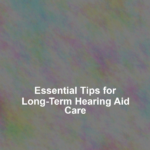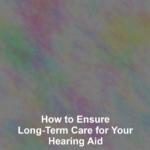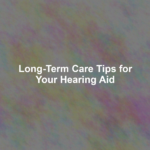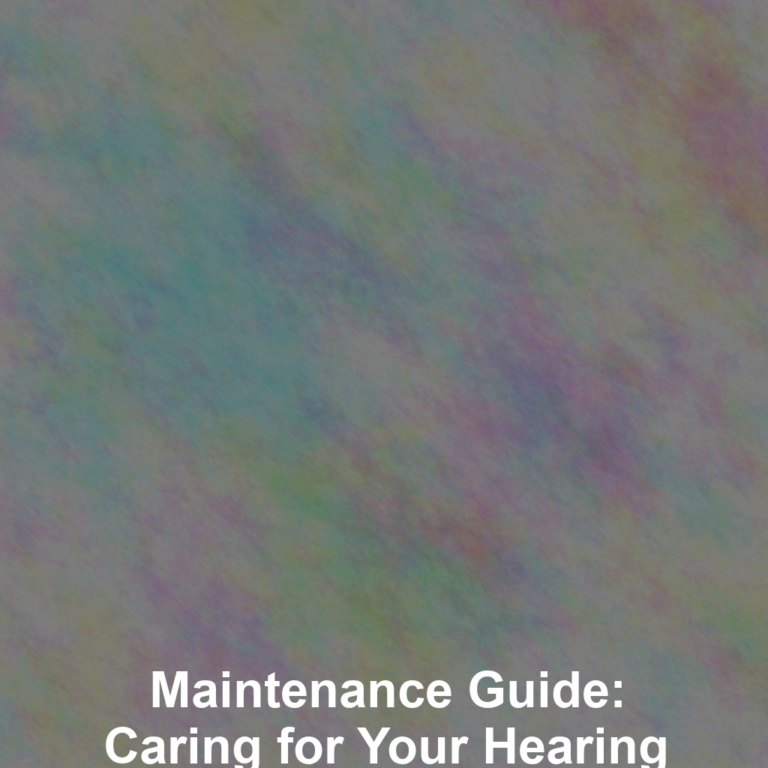Enhancing Hearing Aid Effectiveness with Consistent Maintenance Practices
To achieve the best possible performance from hearing aids, regular maintenance, particularly through the timely replacement of tubes, is crucial. Many users tend to overlook the significance of this maintenance, yet it plays a vital role in enriching their overall hearing experience. By recognising the importance of tube replacement, users can immerse themselves in the intricate soundscapes that life presents, fully appreciating conversations, music, and ambient sounds. Proactively engaging in these maintenance practices not only improves sound quality but also fosters a profound appreciation for the auditory aspects of everyday life, ultimately enhancing overall ear health and user satisfaction.
Preventing Ear Infections with Timely Hearing Aid Tube Replacements

One of the most compelling reasons for regularly replacing hearing aid tubes is to significantly reduce the risk of ear infections. Over time, moisture can accumulate within the tubes, creating a conducive environment for bacteria to flourish. This concern is especially pertinent for those who wear their hearing aids throughout the day, as they are more susceptible to such risks. Studies have shown that untreated ear infections can lead to severe complications, highlighting the critical nature of timely tube replacements. By proactively replacing tubes, users can effectively diminish moisture build-up, thus minimising the likelihood of infections and safeguarding their overall ear health.
Furthermore, the importance of hygiene in maintaining ear health cannot be overstated. Users are encouraged to integrate tube replacements into their regular care routines, ensuring they clean their devices frequently to prevent moisture and bacterial accumulation. This practice becomes even more crucial for individuals residing in humid climates, where excess moisture can significantly heighten the risk of infections. By committing to consistent maintenance, users not only protect themselves from potential health issues but also enhance their comfort while engaging with their hearing aids.
Preserving Optimal Sound Quality with Regular Tube Replacements
Hearing aids are ingeniously designed to elevate the listening experience, yet damaged or worn tubes can drastically undermine sound quality. Even minor wear over time can lead to substantial alterations in sound transmission, resulting in muffled or distorted audio that can be frustrating for users. Recognising these signs is crucial, as they often indicate that a replacement is overdue, which is essential for restoring sound clarity and richness.
Consistently replacing tubes guarantees that sound is transmitted clearly and efficiently, allowing users to fully engage in conversations, appreciate music, and enjoy environmental sounds without any distortion. In settings where background noise is prevalent, such as bustling cities or vibrant markets, maintaining exceptional sound quality becomes even more vital. The enhanced clarity that newly replaced tubes provide can significantly improve a user’s ability to interact with their surroundings, whether navigating crowded streets or enjoying a peaceful evening at home.
Prolonging Hearing Aid Lifespan Through Effective Maintenance Practices
Engaging in proper maintenance, including the timely replacement of hearing aid tubes, plays a critical role in extending the lifespan of these essential devices. Considering the substantial investment associated with hearing aids, committing to regular maintenance translates into long-term financial savings. Failing to replace tubes as needed could lead to more severe issues, necessitating costly repairs or even the acquisition of entirely new devices, which can be avoided with diligent care.
Moreover, many manufacturers provide specific guidelines regarding the recommended replacement schedules to optimise the lifespan of hearing aids. Following these recommendations not only protects the initial investment but also helps users maintain a consistent level of hearing quality. By adopting these preventative measures, users can maximise their enjoyment of hearing aids while avoiding the financial strain associated with frequent replacements.
Enhancing Comfort and Fit for an Improved Hearing Experience

Comfort and an appropriate fit are paramount for every hearing aid user. Over time, tubes may become warped or lose their elasticity, leading to discomfort when wearing the device. This issue is notably significant for individuals with active lifestyles or those who rely on their hearing aids for extended periods. Regularly replacing tubes ensures a snug fit, allowing users to feel comfortable during all their daily activities, thus enhancing their overall experience.
In addition to boosting comfort, well-fitted hearing aids greatly improve overall satisfaction and compliance. Users who experience discomfort may be less inclined to wear their devices consistently, which can negatively impact their hearing health. By ensuring a seamless fit through regular maintenance, users are encouraged to continue using their hearing aids, ultimately promoting better hearing outcomes and enriching their daily lives.
Recognising the Signs That Indicate Hearing Aid Tubes Require Replacement
Identifying the signs that indicate hearing aid tubes need replacement is crucial for maintaining optimal performance. Users should remain vigilant for any changes in their devices and take proactive measures to ensure their hearing aids function at their best.
Spotting Visible Cracks or Damage on Hearing Aid Tubes
Visible damage serves as a clear indicator that hearing aid tubes require replacement. Any cracks or breaks can compromise the structural integrity of the tubes, leading to diminished performance and noticeable alterations in sound quality. Users should routinely inspect their tubes for any visible signs of wear and tear to ensure optimal functionality.
Even minor cracks can lead to sound leakage, which can cause frustration and a compromised listening experience. Users who observe any signs of damage should prioritise replacing their tubes to prevent further complications. Additionally, individuals living in extreme climates, such as those subjected to harsh heat or cold, may experience increased wear and tear, making regular inspections even more essential to maintain device effectiveness.
Identifying Changes in Sound Quality as a Replacement Signal

If users notice a sudden change in sound quality, such as muffled sounds or distortion, this may indicate that a replacement is necessary. Regularly monitoring sound quality can assist users in identifying when it’s time to take action and replace their tubes.
Muffled sounds may suggest blockages caused by earwax or moisture accumulation, while distortion could point to structural damage within the tubes themselves. In either scenario, timely replacements are essential. Users should be proactive and consult their audiologists if they observe any changes in sound quality, ensuring they maintain the best possible hearing experience and quality of life.
Experiencing Difficulty Inserting Tubes: A Clear Sign of Wear
Inserting hearing aid tubes should be a straightforward and uncomplicated process. If users encounter challenges when attempting to insert the tubes into the ear canal, it may indicate that wear has compromised the fit. Over time, tubes can become warped or lose their shape, leading to discomfort and difficulties during use.
Regularly replacing tubes ensures ease of use, maintaining both comfort and proper fit for users. This aspect is particularly critical for those with active lifestyles who depend on their hearing aids for daily communication. A smooth experience when inserting and removing tubes contributes to overall satisfaction, encouraging users to maintain consistent usage of their devices for optimal hearing.
Increased Noise Levels: A Clear Indicator for Replacement
An increase in background noise or static can also signal that it’s time to replace hearing aid tubes. If users observe that their hearing aids are picking up more ambient noise than usual, this could indicate that the tubes are not functioning properly and need attention.
Regular replacements help maintain optimal sound quality and minimise unwanted noise, allowing users to focus on what matters most—meaningful conversations and the sounds of their environment. Keeping a keen awareness of sound quality can assist users in determining when to schedule replacements, ensuring they always benefit from clear and crisp audio.
Understanding the Influence of Environmental Factors on Hearing Aid Tubes
Environmental conditions can significantly impact the longevity and effectiveness of hearing aid tubes. Users should be mindful of how factors such as moisture, dust, and temperature fluctuations can affect their devices and necessitate more frequent replacements.
The Harmful Effects of Moisture on Hearing Aid Tubes
Moisture is one of the primary culprits behind the degradation of hearing aid tubes. Factors such as humidity, perspiration, and condensation can infiltrate the tubes, resulting in corrosion and promoting bacterial growth. For users residing in coastal regions or areas with high humidity levels, this exposure can be particularly detrimental.
Regular tube replacements can effectively combat the adverse effects of moisture. Implementing protective measures, such as using drying kits or storing hearing aids in dry environments, can further extend the lifespan of tubes. Users should remain vigilant in monitoring their devices under humid conditions and act promptly to replace tubes as necessary to ensure optimal functionality.
Mitigating the Effects of Dust and Debris on Hearing Aid Functionality
Dust and debris can easily clog hearing aid tubes, significantly reducing their effectiveness. Users who frequently occupy dusty environments, such as construction sites or agricultural areas, may find that their tubes require more frequent cleaning and replacement to maintain optimal sound quality.
To mitigate these effects, users should establish regular cleaning routines and replace tubes as needed. The accumulation of dust can lead to diminished sound quality, creating a frustrating experience for users. By maintaining clean tubes, individuals can extend the lifespan of their hearing aids and ensure optimal performance in their auditory experiences.
The Impact of Temperature Fluctuations on Hearing Aid Tubes
Extreme temperature variations can also affect the structural integrity of hearing aid tubes. Exposure to high heat or cold can cause materials to expand and contract, leading to wear and tear over time. This concern is particularly relevant for users in regions that experience significant seasonal temperature changes.
To mitigate these impacts, users should store their hearing aids in climate-controlled environments whenever feasible. Regular replacements can help address any damage caused by temperature fluctuations, ensuring that tubes remain functional and effective. By being attuned to environmental conditions, users can make informed decisions regarding their maintenance routines, leading to enhanced device longevity.
Recognising Material Degradation in Hearing Aid Tubes
Like any device, hearing aid tubes experience material degradation over time. Understanding the various factors contributing to this degradation can empower users to take proactive steps in their maintenance schedules, ensuring optimal performance.
Understanding Natural Wear and Tear in Hearing Aid Tubes
All materials ultimately degrade due to regular use, and hearing aid tubes are no exception. Over time, even the highest-quality materials will experience natural wear and tear, necessitating periodic replacements to maintain optimal performance and functionality.
Users should establish a replacement schedule that considers their usage patterns and the specific conditions they encounter daily. For individuals who wear their hearing aids consistently, this could mean more frequent replacements to ensure that their devices remain in peak condition. Recognising the signs of wear, such as changes in comfort or sound quality, can empower users to take action before issues escalate, preserving the functionality of their hearing aids.
Addressing Chemical Breakdown in Hearing Aid Tubes
Hearing aid tubes are often exposed to oils from the skin and earwax, which can lead to chemical breakdown over time. This degradation can compromise both comfort and sound quality, necessitating regular replacements to preserve optimal performance.
Users should be aware of the materials utilised in their hearing aids and how they interact with environmental factors. For example, individuals with oily skin may find that their tubes degrade more rapidly due to increased exposure to skin oils. Regular cleaning and timely replacements can help mitigate these effects, enhancing the longevity and effectiveness of the devices.
Recognising the Aging of Materials in Hearing Aid Tubes
As hearing aid tubes age, they may lose elasticity, causing them to become brittle and susceptible to breakage. This deterioration can lead to significant issues if not addressed promptly. Users should be vigilant for signs of aging materials, such as increased difficulty in fitting tubes or visible cracking.
Taking proactive steps to replace aging tubes can help ensure a continuous and comfortable hearing experience. Users should consult with their audiologists regarding the best replacement intervals based on their individual usage patterns and environmental factors, ensuring their devices remain effective for as long as possible.
Prioritising Hygiene and Health for Hearing Aid Users
Maintaining hygiene and health is paramount for individuals using hearing aids. Regularly replacing tubes forms a key aspect of this maintenance, promoting better ear health and overall user satisfaction through improved hearing experiences.
Preventing Earwax Buildup with Consistent Tube Replacement
Earwax accumulation is a frequent issue that can obstruct hearing aid tubes, leading to diminished sound quality and potential discomfort. By consistently replacing tubes, users can help prevent earwax build-up, maintaining clear sound pathways that enhance their auditory experience.
Establishing a routine that incorporates regular cleaning and tube replacement can significantly improve sound clarity and comfort. Users should consult with professionals regarding the best practices for ear hygiene, ensuring they do not inadvertently compromise their hearing devices while maintaining optimal ear health.
Minimising Bacterial Growth Through Regular Tube Replacements
The accumulation of bacteria in hearing aid tubes can pose serious health risks. Regular replacements significantly reduce the likelihood of bacterial growth, promoting better ear hygiene and overall health for users.
In environments where bacteria prevalence is higher—such as in communal spaces or during flu season—being diligent about tube replacements can help safeguard users from infections and other complications. Prioritising hygiene and ensuring that hearing aids remain in good condition can substantially reduce the risk of health issues, contributing to a more enjoyable and safe auditory experience.
Enhancing Personal Comfort with Well-Maintained Tubes
Regularly replaced tubes play a crucial role in enhancing user comfort. Well-maintained tubes not only improve sound quality but also minimise irritation and discomfort associated with poorly fitting or degraded materials, which can deter users from wearing their devices.
For individuals who wear their hearing aids for extended periods, the comfort afforded by fresh tubes can lead to increased compliance and overall satisfaction. Users should advocate for their comfort by prioritising regular maintenance and replacing tubes as necessary to ensure a pleasant auditory experience.
Embracing Technological Innovations in Hearing Aid Tubes
As technology evolves, so too do hearing aids and their components. Staying informed about advancements in tube materials and designs can significantly enhance the overall hearing experience for users, providing them with more effective and comfortable options.
Utilising Advanced Materials for Improved Durability and Comfort
Innovations in tube materials provide users with enhanced durability and comfort. Manufacturers are continuously striving to produce tubes that can withstand environmental challenges while ensuring optimal sound transmission.
These modern materials often come with added benefits, such as moisture resistance and improved flexibility. Users should consider upgrading to these innovative designs to take advantage of enhanced performance. Embracing new technology is essential for users looking to maximise their hearing aids’ potential and overall auditory experience.
Exploring Enhanced Design Features for a Superior Listening Experience
Innovative design features in contemporary hearing aid tubes can revolutionise the listening experience. Enhanced sound transmission technologies and ergonomic designs improve usability and comfort, prompting users to replace older tubes with upgraded models for better performance.
For instance, some newer tubes are engineered to reduce wind noise or enhance clarity in challenging listening environments. Users who frequently navigate noisy settings will greatly benefit from these advancements, leading to a more enjoyable auditory experience overall, with clearer sounds and improved communication.
Ensuring Compatibility with Emerging Hearing Aid Models
As hearing aid technology progresses, the compatibility between tubes and devices can shift. New models may require updated tubes to function correctly, emphasising the importance of staying informed about the latest advancements in hearing aid technology.
Users should consult with their audiologists to understand the best options for their specific hearing devices. This awareness ensures that users can fully capitalise on the latest technology, enhancing their overall hearing experience and satisfaction with their devices.
Adapting to Changes in Ear Shape for Optimal Hearing Aid Fit
Over time, natural changes in ear shape may impact how well hearing aids fit. Regular replacement of tubes plays a vital role in ensuring a comfortable fit, effectively accommodating these changes and enhancing the overall user experience.
Adjusting for Natural Changes in Ear Shape Over Time
As individuals age, their ear shapes may change due to factors such as weight fluctuations or the natural aging process. These changes can influence how well hearing aids fit, thereby affecting both comfort and sound transmission quality.
Regular tube replacements allow users to maintain a snug fit, ensuring their devices continue to perform optimally. Consultations with audiologists can help users identify the best practices for accommodating ear shape changes, ultimately enhancing their overall hearing experience and satisfaction with their devices.
Ensuring Optimal Performance and Comfort
A well-fitted hearing aid is essential for sustaining optimal performance. Users who encounter discomfort or ill-fitting devices may be less likely to wear them consistently, leading to missed opportunities for improved hearing and communication.
By prioritising regular maintenance and timely tube replacements, users can enjoy maximum comfort and performance from their hearing aids. This proactive approach encourages consistent use, promoting better hearing health and outcomes over time, ultimately enriching their quality of life.
Common Questions About Hearing Aid Tube Maintenance
How often should I replace my hearing aid tubes for optimal performance?
It is generally advisable to replace hearing aid tubes every three to six months, depending on factors such as usage patterns and environmental conditions. Regular inspections can help determine the best schedule for replacements, ensuring optimal performance.
What signs indicate that my hearing aid tubes need to be replaced?
Common signs include visible cracks or damage, noticeable changes in sound quality, difficulty inserting tubes, and an increase in background noise. Regular monitoring of these elements can help maintain optimal performance and user satisfaction.
Is it possible to clean my hearing aid tubes instead of replacing them?
While cleaning can assist in maintaining tubes temporarily, it is crucial to replace them regularly to ensure optimal performance and hygiene for your hearing aids, preventing further complications.
How does moisture affect my hearing aid tubes?
Moisture can lead to bacterial growth and material degradation in tubes, necessitating more frequent replacements. Users should exercise caution in humid environments to protect their devices and ensure longevity.
What should I do if I experience discomfort while using my hearing aids?
If discomfort occurs, inspect for any signs of wear and consider replacing the tubes. Consulting with an audiologist is also recommended for personalised adjustments to improve comfort and functionality.
Are there specific brands of tubes that are considered superior?
The best tube brand can vary based on individual needs and the specific models of hearing aids. Consulting with your audiologist can help identify the most suitable options tailored to your hearing requirements.
Do I need a prescription to obtain replacement tubes?
Most replacement tubes do not require a prescription, but it’s advisable to consult with an audiologist to ensure compatibility with your hearing aids and to receive guidance on appropriate choices.
Can I replace my hearing aid tubes on my own?
Yes, many users can replace their own tubes. However, it is essential to follow the manufacturer’s instructions carefully and consult an audiologist if you are uncertain about the process to ensure proper handling.
How does regular maintenance influence the overall cost of hearing aids?
Regular maintenance, including tube replacement, can significantly extend the lifespan of hearing aids, potentially saving users money on replacements and repairs over the long term, making it a worthwhile investment.
What additional maintenance should I perform on my hearing aids?
In addition to tube replacements, users should regularly clean their devices, check battery life, and schedule routine check-ups with their audiologists to ensure optimal performance and longevity of their hearing aids.
Explore our world on X!
The post Hearing Aid Tubes: Essential Tips for Replacement and Care appeared first on The Microsuction Ear Wax Removal Network.






